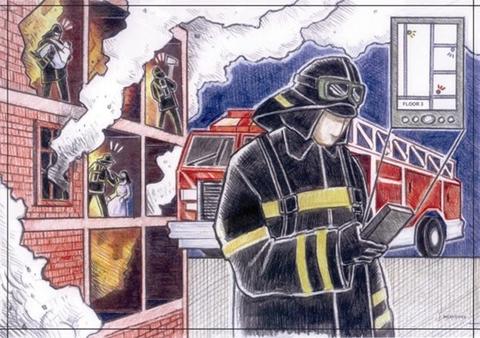Indoor Localization at NIST
Navigation
- Indoor Localization at NIST
- What is Indoor Localization and Tracking?
- Back to Location-Based Services portfolio page
Introduction

Localization and tracking is the key enabler for Location Based Services (LBS). The dominant and highly effective solution for “outdoor” localization and tracking is the Global Navigation Satellite System (GNSS), which includes the Global Positioning System (GPS). It can be argued that the outdoor problem has been successfully solved and GNSS already meets the requirements for most outdoor applications of localization and tracking. There is still a good bit of ongoing R&D focused on making GNSS even more accurate, faster, less of a drain on battery power, etc. The “indoor”, however, is an entirely different story. The indoor problem, for the most part, is still unsolved. It is much harder to solve than the outdoor problem. The purpose of this web page is to provide a history of indoor localization research at NIST.
To the best of our knowledge, the earliest work at NIST on localization and tracking dates back to mid-1990s and the pioneering work of William C. Stone, who investigated the propagation of RF signals through construction materials. Stone studied the attenuation of the RF signal and its time-of-flight as it passes through a layer of construction material. He looked at various construction materials and layers of various thicknesses on the path between a transmitter and a receiver. Stone was interested in "where things are" at a construction site, and his work was applicable to both outdoor and indoor environments.[1], [2]

Stone’s work was followed by 19 years of research on indoor localization and tracking at the Advanced Network Technologies Division1 (ANTD) at NIST during 2002-2021 and two years of work at the Smart Connected Systems Division (SCSD) during 2021-2023. The work in ANTD started with the development of a Wi-Fi fingerprint localization system that employed a Markov chain human mobility model. The system was prototyped and tested on a laptop computer as well as a mobile device (called Personal Data Assistant or PDA back then) that showed the location of the person carrying the laptop/PDA on the floor plan of the building in real-time.
Considerable amount of work on indoor localization and tracking was done at ANTD. The work fell in several categories, including basic research, development and prototyping of indoor localization and tracking systems, standardization, testing of indoor localization and tracking systems, and working with various user communities and other federal government agencies to understand user requirements, operating conditions, and performance of various systems. It would take considerable effort to describe and document all the work that has been done since 2002. In lieu of that, we provide a publication list with electronic copies of our papers, reports, and presentations. The only exception to this is the PerfLoc Prize Competition, the details of which have been presented in several web pages. The primary focus of these web pages is on our recent/ongoing projects and activities.
The work on the LBS Portfolio in the Public Safety Communications Research (PSCR) Division started in 2017. An effort has been made to present a lot of the work that has been done at PSCR in these pages.
References
[1]William C. Stone, "NIST Construction Automation Program Report No. 1: Non-Line-of-Sight (NLS) Construction Metrology," NIST Internal Report (NISTIR) – 5825, February 1996.
[2] William C. Stone, "Electromagnetic Signal Attenuation in Construction Materials," NIST Interagency/Internal Report (NISTIR) - 6055, October 1997.
Footnotes
1 ANTD was reorganized in 2022, and it no longer exists.

